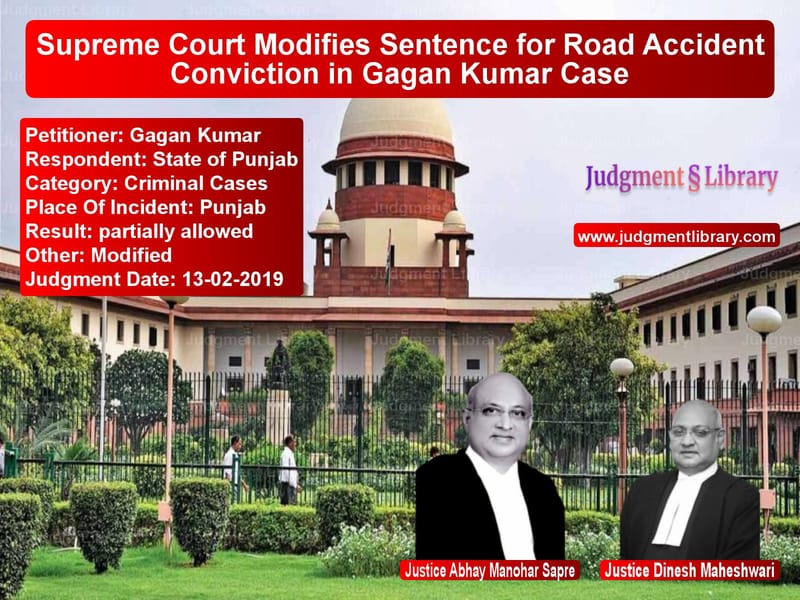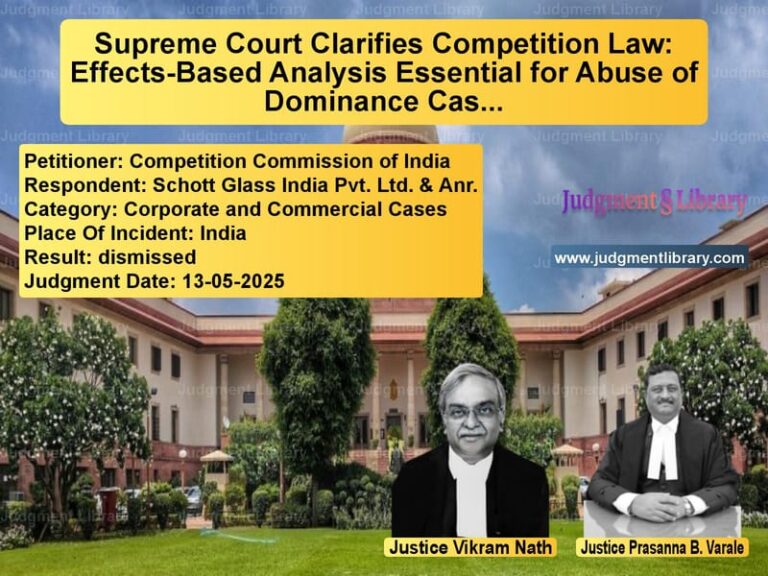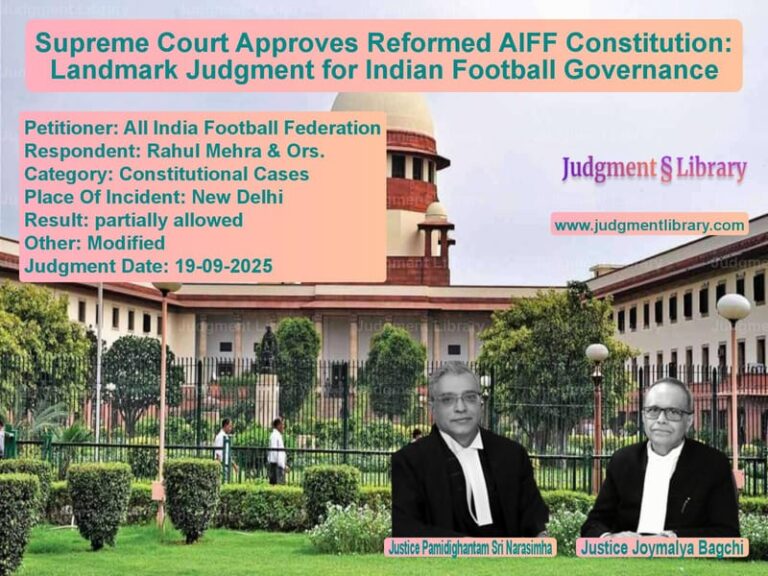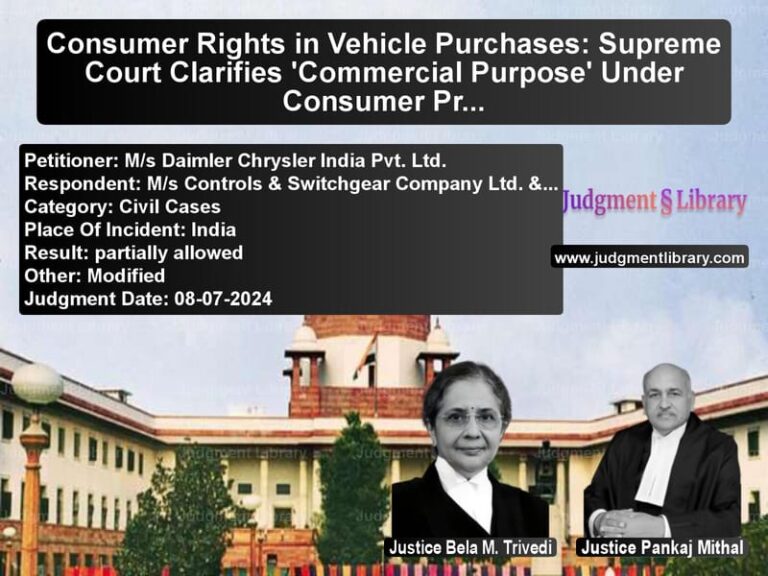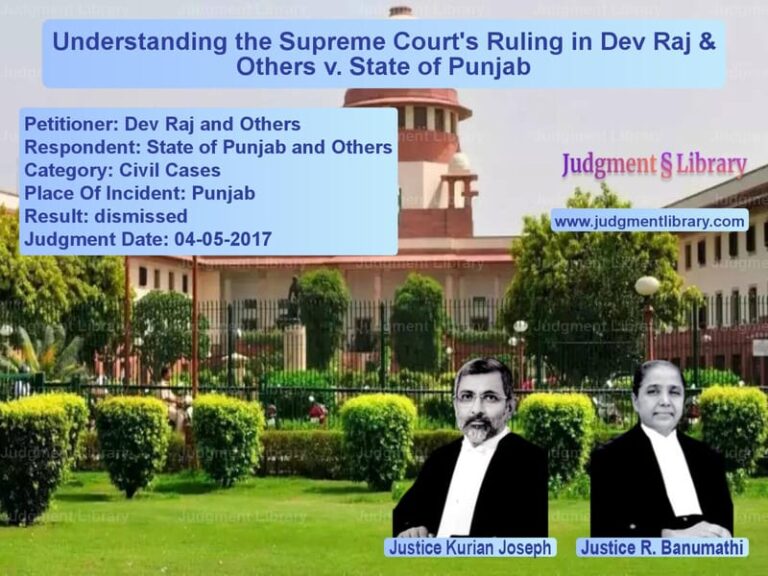Supreme Court Modifies Sentence for Road Accident Conviction in Gagan Kumar Case
The case of Gagan Kumar vs. The State of Punjab is a significant Supreme Court ruling involving the conviction of an individual for causing a fatal road accident. The appellant, Gagan Kumar, was convicted under Sections 279 and 304-A of the Indian Penal Code (IPC) for causing the death of a pedestrian due to reckless driving. However, the appeal before the Supreme Court focuses on the technicality of sentencing, specifically regarding the concurrent versus consecutive nature of the sentences imposed by the trial court.
Background of the Case
On October 18, 2013, Gagan Kumar was driving his car at a high speed when he collided with a pedestrian, Sitaram, who was crossing the road. Sitaram was knocked down and later succumbed to his injuries. The appellant was charged with causing the accident and was found guilty by the Judicial Magistrate under Section 279 (rash driving) and Section 304-A (causing death by negligence) of the IPC.
By order dated May 12, 2017, the Judicial Magistrate sentenced the appellant to six months of rigorous imprisonment and a fine under Section 279 IPC, and two years of rigorous imprisonment and a fine under Section 304-A IPC. In the event of non-payment of the fine, the appellant was directed to undergo additional simple imprisonment. Aggrieved by this, the appellant filed an appeal, challenging the trial court’s sentence.
The Additional Sessions Judge upheld the conviction but did not address the specific issue of whether the two sentences would run concurrently or consecutively. The matter was then escalated to the High Court, which dismissed the appellant’s appeal. The appellant then filed a Special Leave Petition (SLP) before the Supreme Court, seeking a revision of the sentence order.
Key Legal Issues
- Whether the trial court erred in not specifying whether the sentences under Sections 279 and 304-A IPC would run concurrently or consecutively.
- Whether the appellant’s request for concurrent sentencing should be granted based on the facts of the case.
- Whether the appellant’s conviction and sentence were appropriate given the circumstances of the accident.
Arguments Presented
Appellant’s (Gagan Kumar) Arguments
- The trial court’s failure to specify whether the two sentences would run concurrently or consecutively was a procedural error.
- Under Section 31(1) of the Code of Criminal Procedure, when an accused is convicted of multiple offences in a single trial, the court is required to specify whether the sentences would run concurrently or consecutively.
- Given the nature of the accident and the circumstances of the case, the sentences should run concurrently.
- The appellant did not have a prior criminal record, and the accident was not premeditated but rather caused by a lapse in judgment.
Respondent’s (State of Punjab) Arguments
- The trial court’s judgment was correct, and there was no legal requirement to specify whether the sentences should run concurrently or consecutively.
- The appellant’s actions were reckless, and the sentences were justified given the gravity of the offence.
- The appellant should serve the sentences as imposed by the trial court, as it was within the discretion of the court to determine the nature of the sentences.
Supreme Court’s Observations and Judgment
1. Mandatory Provision of Section 31 of the Code of Criminal Procedure
The Supreme Court emphasized that under Section 31(1) of the Code of Criminal Procedure, when a person is convicted for more than one offence in a trial, the trial court must specify whether the sentences would run concurrently or consecutively. The Court noted:
“It is a statutory requirement for the trial court to clarify whether sentences for multiple offences will run concurrently or consecutively. The failure to do so in this case is an error that must be corrected.”
2. Nature of Sentences
The Court agreed with the appellant’s argument that the two sentences should run concurrently. It observed:
“Considering the facts of the case and the fact that the appellant was convicted for two separate offences arising from the same incident, the sentences must run concurrently, as prescribed under Section 31(1) of the Code.”
3. Affirming Conviction
The Supreme Court upheld the conviction, noting that the appellant’s actions were reckless, leading to the unfortunate death of an individual. The Court stated:
“The appellant was found guilty after a thorough examination of the evidence, and there is no valid ground to interfere with the conviction. The appellant’s reckless driving caused the death of a pedestrian, and he must be held accountable.”
4. Modification of Sentence
The Court modified the trial court’s sentence by ordering that the two sentences run concurrently. It stated:
“In the interest of justice and fairness, the sentences for Section 279 and Section 304-A IPC will run concurrently. This ensures that the appellant is not unfairly burdened with excessive imprisonment.”
Final Judgment
The Supreme Court:
- Modified the trial court’s sentence, ensuring that the sentences for Section 279 and Section 304-A IPC run concurrently.
- Affirmed the conviction of the appellant for causing death by negligent driving.
- Upheld the fines imposed by the trial court, with default imprisonment for non-payment.
Legal Implications of the Judgment
The ruling has significant implications for sentencing procedures in criminal cases:
- Reinforcement of procedural fairness: The judgment stresses the importance of following mandatory legal requirements regarding the running of sentences.
- Clarification of sentencing practices: The Court’s ruling establishes a clear precedent for handling concurrent and consecutive sentences in cases involving multiple offences arising from the same incident.
- Accountability of reckless driving: The ruling reaffirms that negligent driving leading to death must be met with appropriate punishment.
- Judicial oversight: The judgment ensures that trial courts comply with statutory requirements to prevent errors in sentencing.
Conclusion
The Supreme Court’s ruling in Gagan Kumar vs. The State of Punjab provides clarity on the application of Section 31 of the Code of Criminal Procedure regarding concurrent and consecutive sentences. By modifying the sentence to run concurrently, the Court has ensured fairness while holding the appellant accountable for the tragic accident. The judgment serves as a reminder of the importance of following legal procedures and safeguarding justice in road accident cases.
Petitioner Name: Gagan Kumar.Respondent Name: State of Punjab.Judgment By: Justice Abhay Manohar Sapre, Justice Dinesh Maheshwari.Place Of Incident: Punjab.Judgment Date: 13-02-2019.
Don’t miss out on the full details! Download the complete judgment in PDF format below and gain valuable insights instantly!
Download Judgment: Gagan Kumar vs State of Punjab Supreme Court of India Judgment Dated 13-02-2019.pdf
Direct Downlaod Judgment: Direct downlaod this Judgment
See all petitions in Bail and Anticipatory Bail
See all petitions in Theft and Robbery Cases
See all petitions in Attempt to Murder Cases
See all petitions in Fraud and Forgery
See all petitions in Judgment by Abhay Manohar Sapre
See all petitions in Judgment by Dinesh Maheshwari
See all petitions in partially allowed
See all petitions in Modified
See all petitions in supreme court of India judgments February 2019
See all petitions in 2019 judgments
See all posts in Criminal Cases Category
See all allowed petitions in Criminal Cases Category
See all Dismissed petitions in Criminal Cases Category
See all partially allowed petitions in Criminal Cases Category

